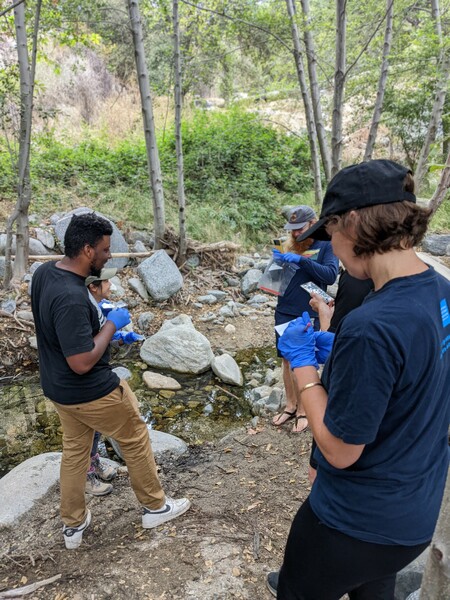Researchers at CALeDNA gathered four groups of volunteers around the Los Angeles area on June 30th for a Bioblitz weekend. Volunteers collected soil and water samples along the LA river to send back to the lab in Santa Cruz for DNA sequencing, which indicates which species were present near the sampling sites and can include everything from bacteria to oak trees to coyotes.
Bioblitz Recap
I attended the Arroyo Seco bioblitz and joined a group of around a dozen other volunteers who were all eager to do some environmental sampling. One of the coolest aspects of citizen science is how it brings together people who share an interest in ecological conservation but come from all different backgrounds. Our research leader, Dr. Rachel Meyer from UC Santa Cruz, showed us what we would be using to collect samples:
- Small plastic containers for soil or sediment samples. The water sampling containers also have filters that trap organic matter.
- Plastic bag with a handy twist tie to hold the sample containers
- Slurpee straws, which are perfect for scooping up sediment from the water and draining the water
- Gloves, so we don't get too much human DNA in the samples
- Soil probe to access soil samples below the surface
- Kobotools web application to record metadata and info around surroundings. It's neat because it works even without wi-fi--you can save records in your browser offline and then upload them when you have signal.
- Water syringe
After a brief primer on how to collect soil, sediment, and water samples, we split off into groups of 3-4 to find a location slightly off the trail and a decent distance from other groups to sample. After using the slurpee straw to grab some sediment from the river, we poured out the water from the other end and dropped the sample into the container. One container down, 2 to go (per sample)! It was a pretty easy process to learn, and it went quickly because we divided up data entry and sample collection amongst our group. The soil samples were even easier as you didn't even need a slurpee straw. The water samples, on the other hand, were the most time consuming and labor intensive. The goal was to fill up the 50 mL water syringe at least 20 times, and after each filling, discharging the water through a special screw-on plastic tube with a filter inside to catch the organic matter. Your hands definitely get a workout from this!
Water Sampling in Action

Context on the Research
The samples we collected would be shipped to the lab at UC Santa Cruz, immediately frozen, and preserved for at least 100 years. Any researcher can request to use these samples to analyze the DNA found in the various sites. For more detail on how the field samples get processed and analyzed, check out these videos. The Arroyo Seco site is a high fire risk zone, and documenting the biodiversity before and after major fires allows researchers to understand the impact of fires on biodiversity and document how organisms recover after major fires.
To see the public DNA data and/or to learn how to get involved, check out https://ucedna.com/
The bioblitz was a great way to meet other locals interested in environmental monitoring, and the online database can support community science projects, such as those involving assessing the presence of bioindicators.

1 Comments
@Bee, @Giiwedin, @JuliaGuerrein, @noah_ben_furman, @michelleiL, here's a recent example of a bioblitz that fellow Fellow Vania attended!
Reply to this comment...
Log in to comment
Login to comment.